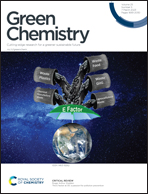Green synthesis of δ-lactam from biomass-derived 4-hydroxy-6-methylpyridin-2(1H)-one†
Abstract
Hydrodeoxygenation is usually an essential step for biomass valorization owing to its highly oxygenated nature, and the catalytic transfer hydrogenation provides a promising alternative for hydrodeoxygenation of biomass feedstocks because of its feasibility and safety. Herein, a novel and sustainable route for δ-lactam production, which was previously produced from non-renewable fossil raw materials via stoichiometric reactions or catalytic reactions, has been demonstrated through catalytic transfer hydrogenation/hydrogenolysis of 4-hydroxy-6-methylpyridin-2(1H)-one (HMPO), which can be easily obtained from biomass-derived triacetic acid lactone (TAL). The Ni–Ru bimetallic catalysts supported on a carbon support had excellent catalytic performance, and the desired product could reach 83.5%, which was much higher than that obtained from other bimetallic or monometallic catalysts and superior to commercial catalysts. The Ru0/RuOx ratios, which can be tuned by the introduction of Ni species in the bimetallic catalysts, played a crucial role in the catalytic system. The Ni–Ru/C catalyst also exhibited good catalytic recyclability.

- This article is part of the themed collection: 2023 Green Chemistry Hot Articles


 Please wait while we load your content...
Please wait while we load your content...